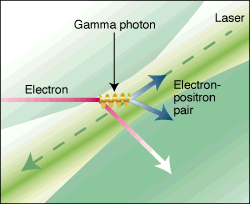|
|
|
|
|
|
Turning matter into light, heat, and other forms of energy is nothing new, as nuclear bombs spectacularly demonstrate. Now a team of physicists at the Stanford Linear Accelerator Center (SLAC) has demonstrated the inverse process--what University of Rochester physicist Adrian Melissinos, a spokesperson for the group, calls "the first creation of matter out of light." In the 1 September Physical Review Letters, the researchers describe how they collided large crowds of photons together so violently that the interactions spawned particles of matter and antimatter: electrons and positrons (antielectrons).

SOURCE: A. MELISSINOS
ILLUSTRATION: D. PUGH
Physicists have long known that this kind of conjuring act is possible, but they have never observed it directly. The experiment is also a proof of principle for a technology, based on intense laser beams boosted to enormous energies with the help of SLAC's electron beam, for exploring a theory known as quantum electrodynamics. QED describes electromagnetic fields, such as those of light, and their interactions with matter, and its predictions are notoriously accurate. But physicists are eager to study it at so-called "critical" electromagnetic fields--fields so strong that their energy can be converted directly into the creation of electrons and positrons.
To create a field as close as possible to critical, the 20-physicist collaboration started with a short-pulse glass laser that packs a half-trillion watts of power into a beam measuring just 6 micrometers across at its narrowest point, resulting in extraordinary intensities. To increase the energy of the photons, the team collided the pulses with SLAC's 30-micrometer-wide pulsed beam of high-energy electrons--a feat that required precise alignment and synchronization. When laser photons collided head-on with the electrons, they got a huge energy boost, much like ping-pong balls hitting a speeding Mack truck, changing them from visible light to very high energy gamma rays. Because of the laser's intensity, these backscattered gamma photons sometimes encountered several incoming laser photons simultaneously; a collision with four of them concentrated enough energy in one place to produce electron-positron pairs.
Melissinos views the result as the first direct demonstration of "sparking the vacuum," a long-predicted phenomenon. In it, the energy of a very strong electromagnetic field promotes some of the fleeting, "virtual" particles that inhabit the vacuum, according to QED, to become pairs of real particles.
Electron-positron pairs are often spawned in accelerator experiments that collide other particles at high energies, and photons produced in the collision are what actually generate the pairs. But at least one of the photons involved is virtual--produced only for a brief moment in the strong electric field near a charged particle. The SLAC experiment marks the first time matter has been created entirely from ordinary photons.
Princeton University physicist Kirk McDonald, another spokesperson for the collaboration, which also includes the University of Tennessee and SLAC, thinks the high-field experiments could shed light on phenomena at the surface of a neutron star, where magnetic fields are very strong, and in other exotic astrophysical settings. On a more practical level, the conversion of light into matter could also give particle physicists a new source of positrons that are exceptionally uniform in energy and momentum.
The result is also the first step toward using powerful lasers and electron beams to test high-field QED predictions, such as what McDonald calls "vacuum optics"--the behavior of light in a strong-field environment. "We're exploring new regimes and trying to map out the basic phenomena," he says. Physicist Tom Erber of the Illinois Institute of Technology looks forward to the results: "Hopefully, this will open the door to future experiments which will approach [more probing] tests of QED."
|
|